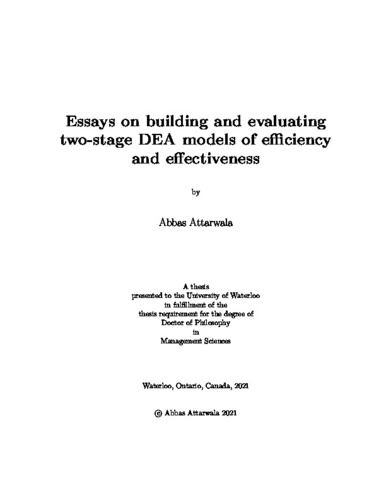| dc.description.abstract | Researchers are not consistent in their choice of input and output variables when using two-stage data envelopment analysis (DEA) models to measure efficiency and effectiveness. This inconsistency has resulted in the development of many different two-stage DEA models of efficiency and effectiveness for the financial industry.
In this dissertation, I improved the statistical method from the MASc dissertation (Attarwala,
2016) by adding more features. These features are documented in Chapter 2 on page 4 and page 5.
This statistical method evaluates efficiency and effectiveness models in the banking industry. It relies on the semi-strong version of the efficient market hypothesis (EMH). The EMH is motivated by the wisdom of the crowds, discussed in Section 2.2.2.
Previously (Attarwala,
2016), I found that the two-stage DEA model of Kumar and
Gulati (2010) is not consistent with the semi-strong EMH for Indian and American banks.
In this dissertation, using my improved statistical method, I show that the two-stage DEA model of Kumar and
Gulati (2010) is not consistent with the semi-strong EMH for banks in Brazil, Canada, China, India, Japan, Mexico, South Korea and the USA from 2000-
2017.
I address the question of whether a universal two-stage DEA model of efficiency and effectiveness exists by building a variable selection framework.
This variable selection framework automatically generates two-stage DEA models of efficiency and effectiveness.
To do this, it uses the improved statistical method and a genetic search (GS) algorithm.
The variable selection framework finds the best, universal, two-stage DEA model of efficiency and effectiveness consistent with the semi-strong definition of EMH for banks in Brazil, Canada, China, India, Japan, Mexico, South Korea and the
USA and from 2000-2017.
I investigated the causal relationship between (a) the quantitative measures of efficiency and effectiveness from the best two-stage DEA model generated by the variable selection framework and (b) Tobin’s Q ratio, a financial market-based measure of bank performance.
Not only do I provide bank managers with a reasonable proxy for measuring efficiency and effectiveness, but I also address the question of whether acting on these input and output variables improves the performance of banks in the financial market.
Finally, I set up an optimization problem and find an optimal path from the two-stage DEA model of Kumar and Gulati (2010) to the best two-stage DEA model found by the variable selection framework.
This optimal path provides a set of actionable items for converting a two-stage DEA model that is not consistent with the semi-strong EMH to one that is. | en |

